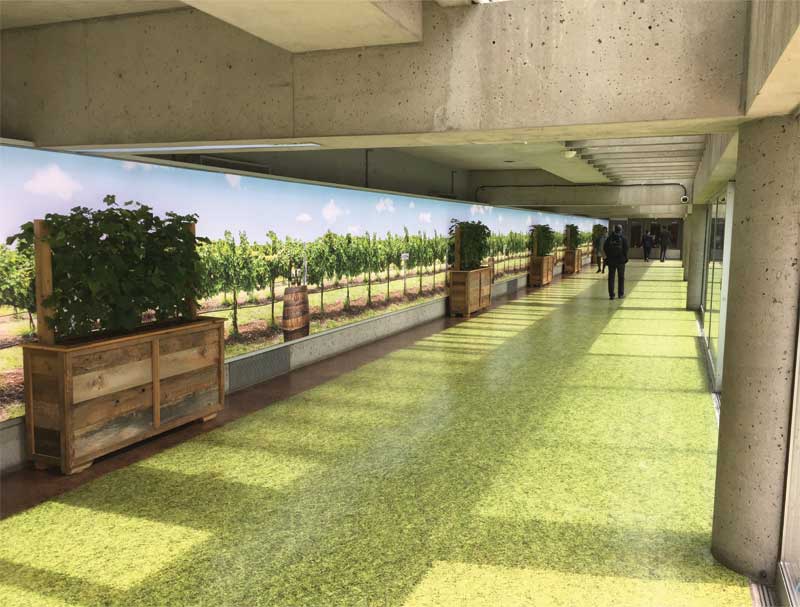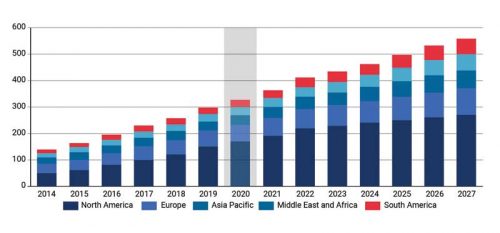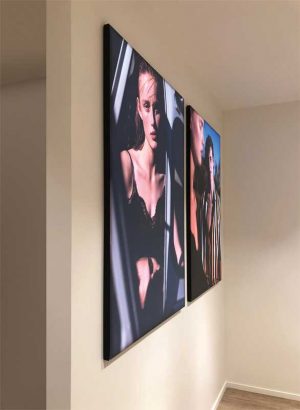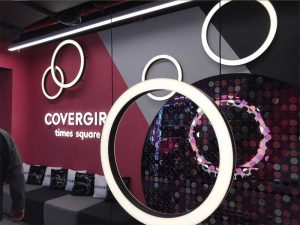Illuminating brands: Standing out in a cluttered digital landscape
by | 23 October 2020 10:01 am
By Mark Mantha and Bill Horst
 [1]
[1]The 66-m (217-ft) lightbox installed in the underground PATH in Toronto fulfils dual objectives of illuminating the entire space and working as an incredibly effective messaging medium and advertising option.
The importance of illumination in the new world (post-COVID) cannot be understated. More than ever, an emotional connection with the consumer in-store will be paramount. From an over-arching perspective any environment will now be morphing as to what consumer engagement looks like—what mechanisms drive relevant behaviour at the “moment of truth” in-store.
To break through the clutter and integrate in a fast-paced digital future, lighting/light boxes can have a dramatic and lasting impact and be extremely cost effective as corporate purse strings and budgets are tightened.
Drawn to the light
Like any creature, we are drawn to light. It is inviting, intriguing, warm, and makes people feel better. Brands should be that beacon drawing in consumers. Lighting sets the stage for the store and can highlight areas where one wants the traffic to flow (or not). Lightboxes can solve two problems—highlighting key brand and product messaging and enhancing (or augmenting) ambient store lighting.
A recent article in MarketWatch suggests online pricing will be more expensive than on premise post-pandemic.[2] Will people be paying a premium for convenience online? As a result, bricks and mortar retail will once again be re-inventing itself. Does the new shopping environment befriend the consumer, speak to them, make them feel appreciated and welcomed, let alone address their needs?
Done correctly, the masses will flock back to ‘the store’ as people are social creatures and (price points notwithstanding) will only do so much online where convenient. So, what does the magic formula look like to create and enhance the shopping experience?
No doubt in-store digital signage will ‘pop’ going forward, with updated applications to include touchless screens (mobile interaction), wayfinding, and social distancing messaging. This lends itself to the consumer being on guard and prepped for direction and brand engagement. Keeping it simple with lightboxes can ensure signage about safety and direction does not drown out brand messaging.
 [3]
[3]The global lightbox market will continue to grow at a very steady pace per a recent report by Cognitive Market Research (June 2020) led by the North American marketplace.
Is that brand speaking to me?
Visual cues is the new language for consumers. The right amount of light in a retail format can make almost anything stand out. The beauty, colour, scheme, detail, and quality of a product will shine through a lot more with correctly backlit signage. The right amount of light and shadow highlights texture and works to elicit emotion from the viewer.
Further, using lightboxes to illuminate a message guarantees consistent visibility. This makes it a lot easier for customers to see and to engage with the product. Clear, concise messaging that separates a brand from the pack is a winning proposition.
Different types of illumination can fit any environment to drive ambience and messaging. The primary types of illumination to consider include:
• Back lit—ideal for most signage applications due to image clarity and no glare, as well high visibility in direct sunlight;
• Large format—stand out with huge seamless messaging to show strength of the brand; and
• Dynamic lighting—add dynamic light-emitting diodes (LEDs) to signage to add movement and turn heads with low cost and versatility.
Thanks to new advancements in technology, lightboxes no longer have to be thicker; they come with all the benefits of existing lightboxes and are more design friendly. New profiles allow for maximum light output in fabric frames as low as 15.8 mm (0.625 in.) thick. Custom-made (built to spec), short build times, no minimums, and North American made have changed the lightbox landscape.
Crystal-clear message
Today, hot and dark spots are a thing of the past when the appropriate light engine is applied as even light distribution across the whole message can be guaranteed. What is key here is an overall lighting strategy that most retailers will not give much thought, including what are the backlit signage objectives and what defines success? These pieces need to be defined to map the store environment in alignment with its customer base.
Zumtobel Group, a supplier of integral lighting solutions for professional indoor and outdoor building lighting applications, claims a fashion retailer in Germany saw its sales go up by approximately 12 per cent compared to another local store, after it installed a new lighting scheme specially designed to appeal to the personality profile of its target customers.
 [4]
[4]Thanks to new advancements in technology, lightboxes no longer have to be thicker; they come with all the benefits of existing lightboxes and are more design friendly.
“The strategic use of quality illuminated graphics and environmental lighting has a proven impact on a positive shopping experience, purchase behaviour and brand loyalty,” says Andrew Pierce, the CEO of
MINT Collaborative.
Steve Goertz, president of Visual Impact, adds: “As our customers create immersive and entertaining environments, they are relying on grand-format lit dye sublimation to make big statements economically inside the lease line, as window treatments, even as ceiling treatments. The ability to economically update these large graphics to match an ongoing digital campaign calendar makes it budget friendly to maintain continuity of messaging.”
The global lightbox market will continue to grow at a very steady pace per a recent report by Cognitive Market Research (June 2020) led by the North American marketplace.
With the North American market leading the way post-pandemic, retailers would be best served by working with companies that:
• Manufacture in North America for best in class;
• Provide custom-made products that are built to spec;
• Provide rapid turnaround times; and
• Provide ‘no minimum’ build requirements.
These pieces are paramount for successful lightbox deployments and long-term partnerships.
The use of lightboxes is also good for a company’s green footprint. They use far less power yet provide superior illumination. Better illumination provides clear and concise messaging driving better lift at retail. Many have heard the term ‘retail is detail,’ and the detail here is understanding how lighting plays such an important role in customer choice.
 [5]
[5]Lightboxes can solve two problems—highlighting key brand and product messaging and enhancing (or augmenting) ambient store lighting.
“Early indications suggest the changes in consumer behaviour during the COVID-19 crisis will largely mirror the changes that manifested themselves during the 2008 recession—but with some unique nuances. We’ve observed, for instance, the familiar flight to value: our recent research shows that 34 per cent of consumers have increased their spending on private-label products during the pandemic and that most of those consumers plan to continue doing so even after the crisis has passed[6]. When asked why they started buying more private-label goods, 44 per cent cited affordability and better value.”
Spin the affordability and better value to retailers themselves as they reinvent their presence in-store, and lightboxes are sure to be the way to creating value all around and keeping price points at bay as consumers become more frugal. Because they can be used to highlight the architecture of any retail space, they are now part of the planning and design conversation with new builds.
Light at the end of the tunnel
The post-COVID-19 world adds more to the customer-centric, customer-first thinking in retail. If needs, wants, and wishes are not met and recognized, any resemblance of customer loyalty has no chance of survival. Consumers will come back; the question remains, however, will they return repeatedly and become evangelists for brands? This will be key to any retail success.
That said, lighting done correctly and effectively can drive retail sales. Retailers can effectively guide consumer traffic in-store to where they want to see people spend more time based on product sets. The level of brightness coupled with the right colours can greatly enhance the warm, ‘comfortable’ areas of the store where high-margin products are displayed.
“Lightboxes allow us to use evocative imagery and branded patterns to support our immersive retail experiences,” says Beverley Wells, vice-president, Branded Environment–Skikatani Lacroix Design. “Specifically, continued advancement in LED technology means we can really use scale to our design advantage.”
The lightbox installed in the underground PATH in Toronto, which is one of the largest fabric backlit lightbox installations in North America, is a good example of this. It is a massive 66 m (217 ft) of visual brilliance fulfilling dual objectives of illuminating the entire space and working as an incredibly effective messaging medium and advertising option.
Mark Mantha, president of Man-Mac Consulting Inc., provides market development consulting for Omnify Lighting, a manufacturer of backlighting products and supporting accessories that are designed and built to co-ordinate and provide a unified lighting solution. He can be reached via email at mark@manmacconsulting.ca[7].
Bill Horst is the vice-president marketing for Omnify Lighting. He holds a bachelor of arts in graphic communications management from Ryerson University and has more than 15 years of experience in marketing leadership. He leads all branding, communications, and advertising for Omnify Lighting. He can be reached via email at bill@omnifylighting.com[8].
- [Image]: https://www.signmedia.ca/wp-content/uploads/2020/10/RTH-Image.jpg
- A recent article in MarketWatch suggests online pricing will be more expensive than on premise post-pandemic.: https://www.marketwatch.com/story/shoppers-will-pay-more-for-the-same-item-online-versus-in-stores-under-new-covid-19-conditions-experts-say-2020-06-19
- [Image]: https://www.signmedia.ca/wp-content/uploads/2020/10/Graph.jpg
- [Image]: https://www.signmedia.ca/wp-content/uploads/2020/10/Sando-Thin-Lightboxes.jpg
- [Image]: https://www.signmedia.ca/wp-content/uploads/2020/10/Covergirl.jpg
- our recent research shows that 34 per cent of consumers have increased their spending on private-label products during the pandemic and that most of those consumers plan to continue doing so even after the crisis has passed: https://www.mckinsey.com/business-functions/strategy-and-corporate-finance/our-insights/economic-conditions-snapshot-june-2020-mckinsey-global-survey-results
- mark@manmacconsulting.ca: mailto:mark@manmacconsulting.ca
- bill@omnifylighting.com: mailto:bill@omnifylighting.com
Source URL: https://www.signmedia.ca/illuminating-brands-standing-out-in-a-cluttered-digital-landscape/